Study on Water Replacement Characteristics of Xinghai Lake Wetland Based on Landscape Water Quality Objectives
Abstract
1. Introduction
2. Data Source and Methods
2.1. Study Area
2.2. Data Source
2.3. Methods
- (1)
- The water requirements of the actual Xinghai Lake wetland, including those for the plants that grow there, for irrigation in the shoreline zone, and landscape water levels.
- (2)
- The daily water replenishment of the Xinghai Lake wetland, including precipitation, seepage, and evaporation.
- (3)
- Starfish Lake wetland replacement water: maintains the landscape water body’s water quality standards, preventing eutrophication and meets the needs of the water environment capacity, protecting the wetland’s functions from being harmed by routine replacement water.
2.3.1. Water Demand Model of Xinghai Lake Landscape Water
- (1)
- Water requirement for evaporation WW:
- (2)
- Water demand of wetland vegetation WP:
- (3)
- Leakage volume WS:
- (4)
- Precipitation WR:
2.3.2. A Two-Dimensional Hydrodynamic-Water Quality Model Based on the MIKE 21 Water System Connectivity
- (1)
- Hydrodynamic model
- (2)
- Water quality model
2.3.3. Water Displacement Cycle Coupled Hydrodynamic-Tracer Model
2.4. Study on the Water Balance of the Water Bodies in Xinghai Lake Wetland
2.4.1. Water Demand of Xinghai Lake Wetland
- (1)
- Evaporation water demand
- (2)
- Wetland vegetation water demand
- (3)
- Seepage water demand
- (4)
- Precipitation
2.4.2. The Water Requirement of Landscape Water Level in Xinghai Lake Wetland
- (1)
- Minimum wetland water level
- (2)
- Standard wetland water level
- (3)
- Maximum wetland water level
2.5. Hydrodynamic Water Quality Modeling
2.5.1. Calculation Area and Grid
2.5.2. Boundary Conditions and Output
2.5.3. Simulation Scheme and Model
- (1)
- Initializing the concentration of the tracer material in Xinghai Lake’s water column at 100 and its inflow concentration at 0.
- (2)
- The simulation duration was chosen as 1st April 2020–1st November 2020, comprising 214 d, taking into account Xinghai Lake’s chilly winter and the lengthy freezing period of the water body.
- (3)
- For the simulation, six distinct flow conditions are chosen, as shown in Table 2, with the water quality in Xinghai Lake’s middle domain serving as the study object.
3. Results and Discussion
3.1. Flow Field Analysis
3.2. Water Replacement Cycle Analysis
4. Conclusions
- (1)
- Xinghai Lake’s water exchange cycle is spatially heterogeneous, exhibiting general characteristics of rapid water renewal in the southern lake area and slow renewal in the northern lake area. The gradient of the water exchange cycle from south to north is closely related to Xinghai Lake’s hydrological situation.
- (2)
- The flow rate, terrain, and wind field all have an impact on the Xinghai Lake flow field. The topography and flow velocity have an impact on the development of many complicated circulations close to the artificial island. The wind field affects the near-shore region, which creates a tiny circulation with a modest flow velocity.
- (3)
- Xinghai Lake is influenced by throughput flow; under high flow conditions, the flow velocity in the lake area is larger, the water body transport speed is faster, and the water exchange capacity is strong; under low flow conditions, the flow velocity in the lake area is slower, the water body mobility is poor, and the water exchange period is longer. Xinghai Lake has a large water area, a complex flow field, and a low flow velocity, and it is a lake system.
- (4)
- Without new water inlets and outlets, the center and northern domain of Xinghai Lake will create a significant area of stagnant water, which does not fulfill the requirements for the water quality of the landscape water body. To optimize the renewal time of the water body, it is recommended to enhance the inlet and outlet and incorporate additional alternative water sources.
- (5)
- The numerical model can be used to determine the flow velocity distribution and hydraulic residence time in the water body, which can be used as an important tool for future water environment management in urban landscape lakes.
Author Contributions
Funding
Data Availability Statement
Conflicts of Interest
References
- Whipple, W., Jr.; Duflois, D.; Grigg, N.; Herricks, E.; Holme, H.; Jones, J.; Keyes, C., Jr.; Ports, M.; Rogers, J.; Strecker, E.; et al. A proposed approach to coordination of water resource development and environmental regulations. JAWRA J. Am. Water Resour. Assoc. 1999, 35, 713–716. [Google Scholar] [CrossRef]
- Tisdell, J.G. The environmental impact of water markets: An Australian case study. Jocase Study Environ. Manag. 2001, 62, 113–120. [Google Scholar] [CrossRef] [PubMed]
- McCallum, B.E. Areal extent of fresh water from an experimental release of Mississippi RiMississippinto Lake Pontchartrain. In Proceedings of the 9th 1995 Conference on Coastal Zone, Tampa, FL, USA, 16–21 July 1995; pp. 363–364. [Google Scholar]
- Cox, W.E. Interbasin water transfer in the United States: Overview of the institutional framework. In Proceedings of the IWRA Seminar on Interbasin Water Transfer, Beijing, China, 15–19 June 1986. [Google Scholar]
- Xu, L.; Gao, X.; Zhang, C.; Wang, C. Numerical simulation-based study on exchange of water in urban artificial lake. Water Resour. Hydropower Eng. 2018, 49, 94–100. [Google Scholar]
- Tang, J.Z.; Zhou, W.B.; An, B.J.; Yang, H.; Li, Y. Research on characteristics of water change capability of Kunming Lake (test section) in Xi’an based on the MIKE 21 Model. J. Water Resour. Water Eng. 2020, 31, 58–63. [Google Scholar]
- Cucco, A.; Umgiesser, G. Modeling the Venice Lagoon residence time. Ecol. Model. 2006, 193, 34–51. [Google Scholar] [CrossRef]
- Delhez, É.J.; de Brye, B.; de Brauwere, A.; Deleersnijder, E. Residence time vs influence time. J. Mar. Syst. 2014, 132, 185–195. [Google Scholar] [CrossRef]
- Meng, Q.B.; Liu, Y.Z.; Tan, Y.M.; Guo, L.; Zhou, Q.J. Study on Water Quantity and Quality Coupled Simulation of Daming Lake and Delivery Scheme. Water Resour. Power 2008, 26, 24–26. [Google Scholar]
- Xu, W.J. Comprehensive Water Requirement Analysis and Ecosystem Health Assessment of Urban Lakes. Ph.D. Thesis, Dalian University of Technology, Dalian, China, 2009. [Google Scholar]
- Wang, S.Q.; Shi, W.; Ouyang, H.; Qiu, X.C.; Zhao, Z.F.; Li, Y.L. Study on the ecological water supply of Xinghai Lake based on water quantity and quality model. J. Gansu Agric. Univ. 2020, 55, 180–186. [Google Scholar]
- Welch, E.B.; Barbiero, R.P.; Bouchard, D.; Jones, C.A. Lake trophic state change and constant algal composition following dilution and diversion. Ecol. Eng. 1992, 1, 173–197. [Google Scholar] [CrossRef]
- Donabaum, K.; Schagerl, M.; Dokulil, M.T. Integrated management to restore macrophyte domination. Hydrobiologia 1999, 395–396, 87–97. [Google Scholar] [CrossRef]
- Yang, W.; Sun, Z.F.; Sun, T. A Review of Requirement Quantity and Allocation of Ecological Water for Wetland. Wetl. Sci. 2008, 6, 531–535. [Google Scholar]
- Hu, G.L.; Zhao, W.Z. Reviews on calculating methods of vegetation ecological water requirement in arid and semiarid regions. Acta Ecol. Sin. 2008, 28, 6282–6291. [Google Scholar]
- Xu, M.J.; Yu, L.; Zhao, Y.W.; Li, M. The Simulation of Shallow Reservoir Eutrophication Based on MIKE21: A Case Study of Douhe Reservoir in North China. Procedia Environ. Sci. 2012, 13, 1975–1988. [Google Scholar] [CrossRef]
- Li, X.; Huang, M.; Wang, R. Numerical Simulation of Donghu Lake Hydrodynamics and Water Quality Based on Remote Sensing and MIKE 21. ISPRS Int. J. Geo-Inf. 2020, 9, 94. [Google Scholar] [CrossRef]
- Zhu, C.; Liang, Q.; Yan, F.; Hao, W. Reduction of Waste Water in Erhai Lake Based on MIKE21 Hydrodynamic and Water Quality Model. Sci. World J. 2013, 2013, 958506. [Google Scholar] [CrossRef] [PubMed]
- Wang, Q.; Peng, W.; Dong, F.; Liu, X.; Ou, N. Simulating Flow of An Urban River Course with Complex Cross Sections Based on the MIKE21 FM Model. Water 2020, 12, 761. [Google Scholar] [CrossRef]
- Liu, J.L.; Yang, Z.F. A study on the calculation methods of the minimum eco-environmental water demand for lakes. J. Nat. Resour. 2002, 17, 604–609. [Google Scholar]
- Schoen, J.H.; Stretch, D.D.; Tirok, K. Wind-driven circulation patterns in a shallow estuarine lake: St Lucia, South Africa. Estuar. Coast. Shelf Sci. 2014, 146, 49–59. [Google Scholar] [CrossRef]
- Tang, C.; Yi, Y.; Yang, Z.; Zhang, S.; Liu, H. Effects of ecological flow release patterns on water quality and ecological restoration of a large shallow lake. J. Clean. Prod. 2018, 174, 577–590. [Google Scholar] [CrossRef]

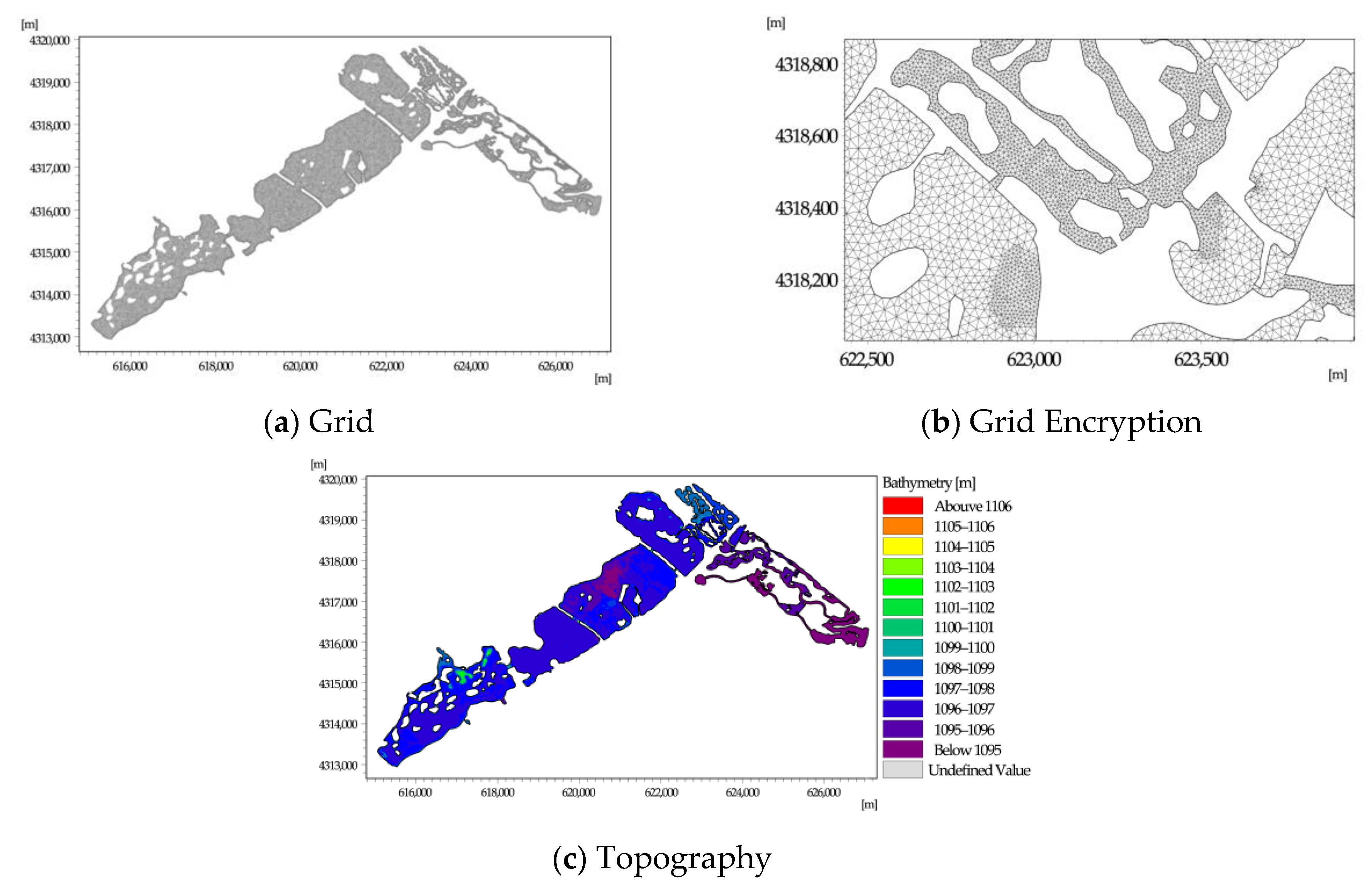
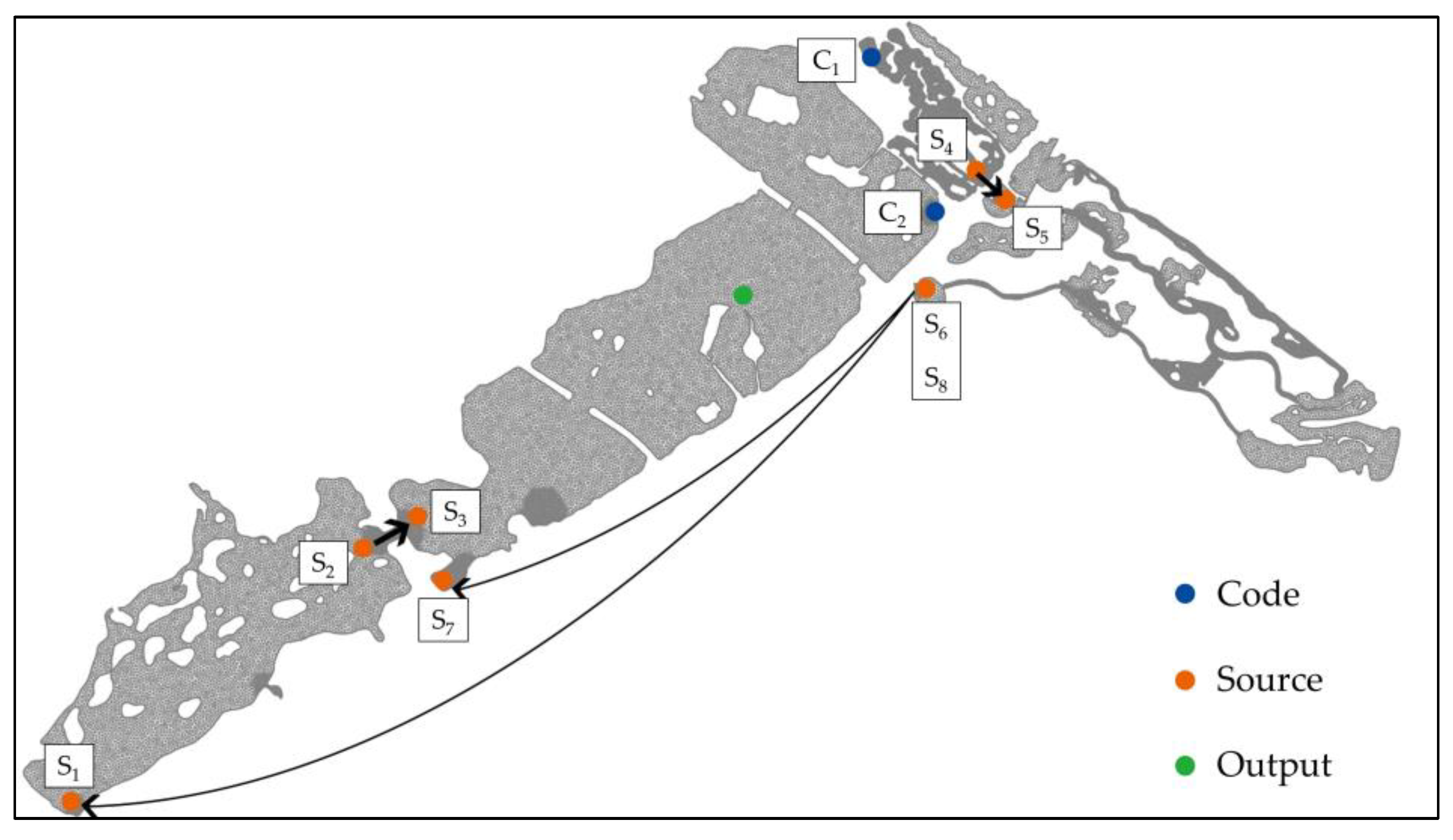
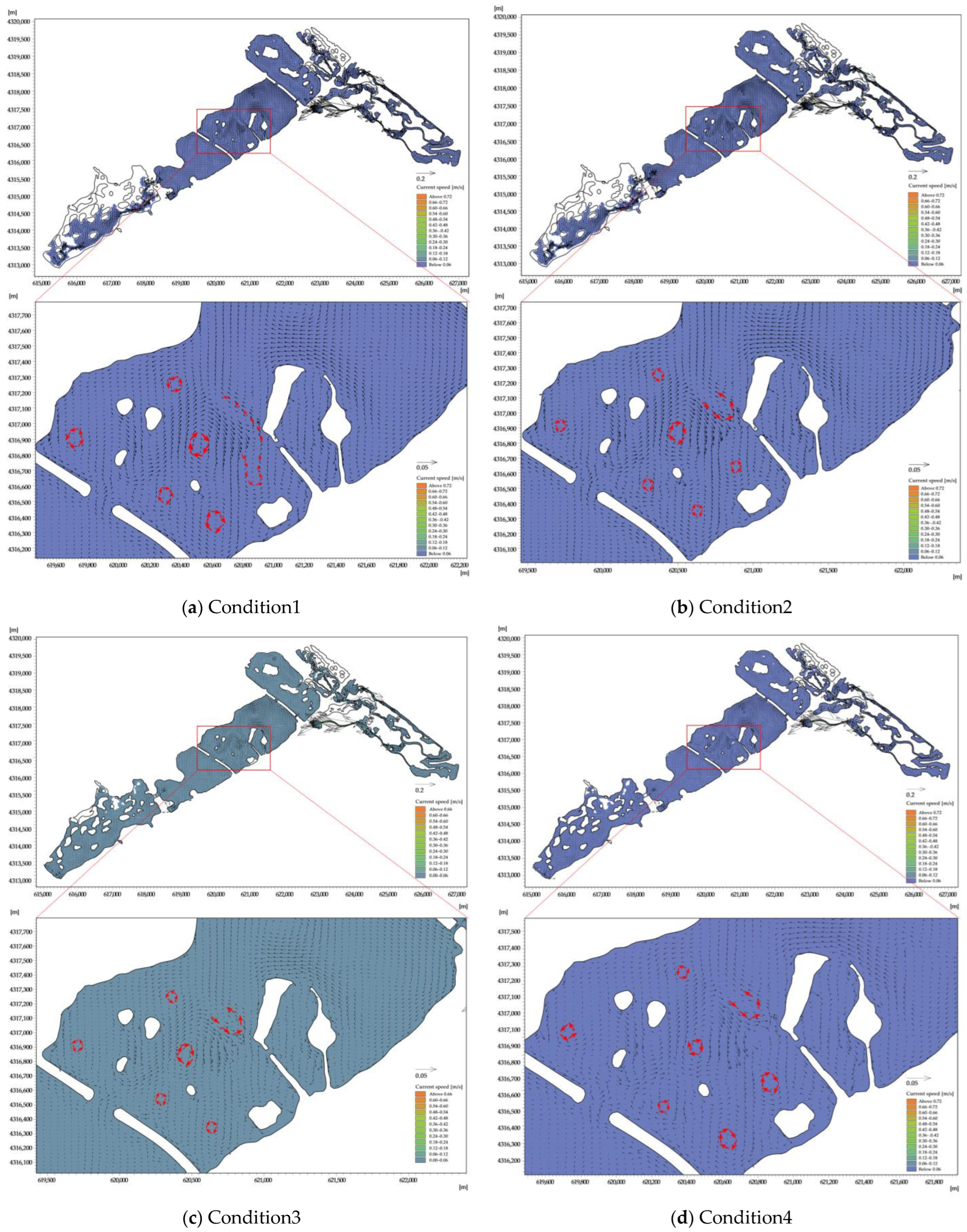



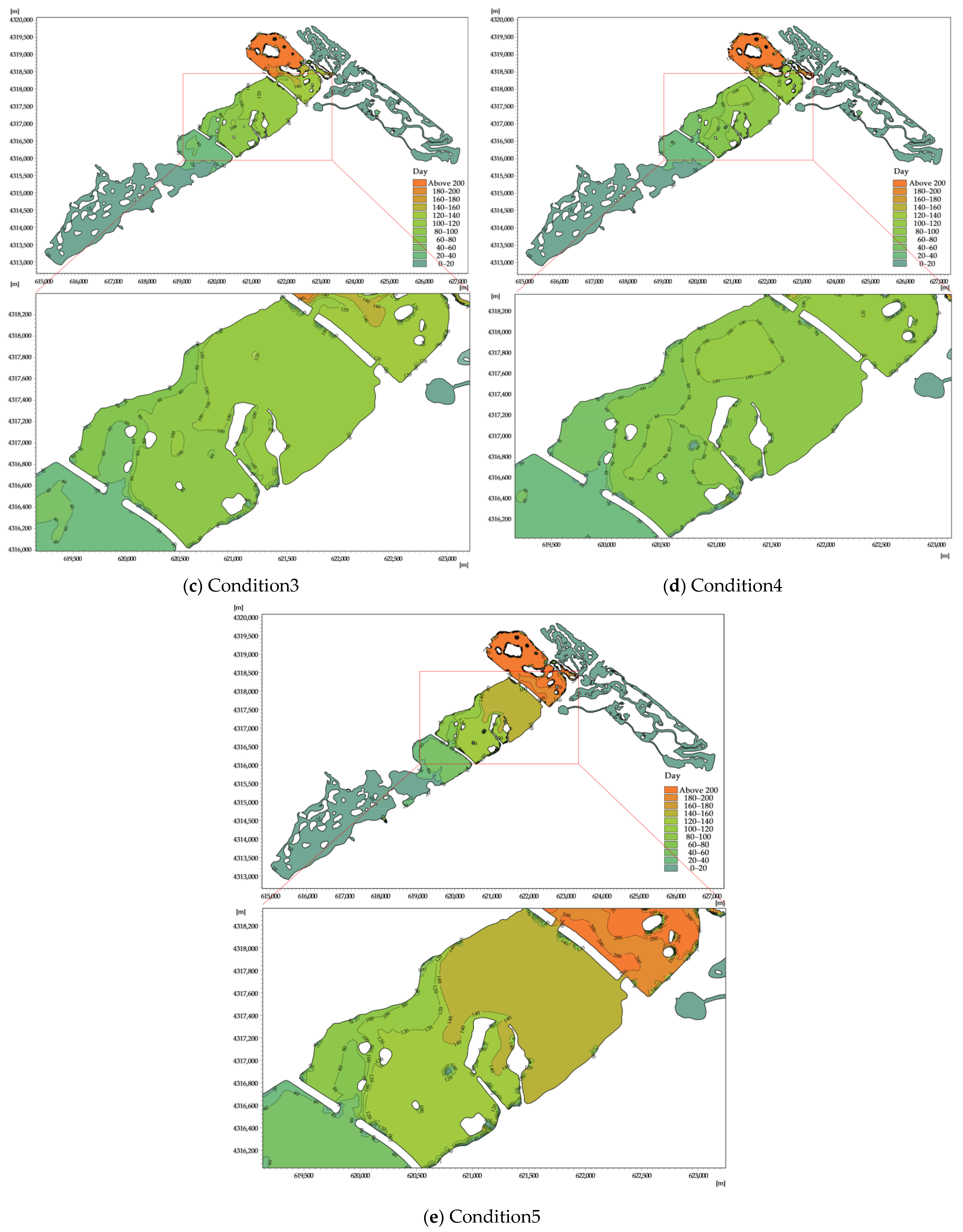
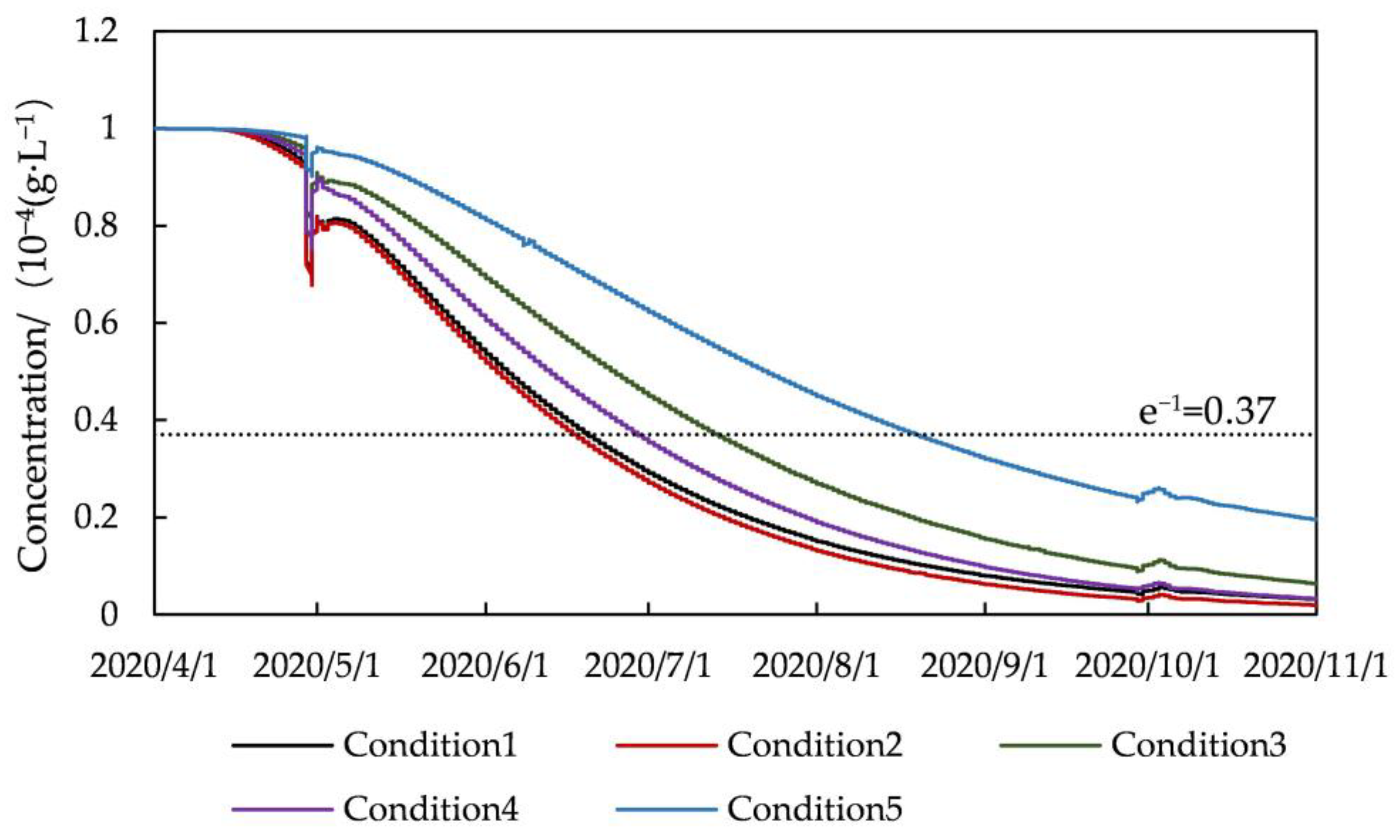
| Domain | Water Surface (km2) | Minimum Water Level (m) | Standard Water Level (m) | Maximum Water Level (m) |
|---|---|---|---|---|
| South domain | 1.54 | 0.2 | 0.3 | 0.4 |
| Central domain | 5.07 | 1.3 | 1.4 | 1.5 |
| North domain | 1.94 | 1.3 | 1.4 | 1.5 |
| East domain | 0.7 | 0.1 | 0.2 | 0.3 |
| New domain | 1 | - | - | - |
| Condition1/(m3/s) | Condition2/(m3/s) | Condition3/(m3/s) | Condition4/(m3/s) | Condition5/(m3/s) | |
|---|---|---|---|---|---|
| Code | 0.8 | 0.55 | 0.8 | 0.55 | 0.8 |
| 1 | 0.7 | 0.7 | 0.7 | 0.7 | 0.7 |
| 2 | −0.7 | −0.7 | −0.35 | −0.35 | −0.7 |
| 3 | 0.7 | 0.7 | 0.35 | 0.35 | 0.7 |
| 4 | −1.39 | −1.39 | −1.39 | −1.39 | −1.39 |
| 5 | 1.39 | 1.39 | 1.39 | 1.39 | 1.39 |
| 6 | −0.7 | −0.7 | 0.7 | −0.7 | −0.7 |
| 7 | 0.7 | 0.7 | 0.7 | 0.7 | 0 |
| 8 | −0.7 | −0.7 | −0.7 | −0.7 | 0 |
| Condition | Average Water Level/m | Average Flow Rate (m/s) | Maximum Flow Rate (m/s) | |||
|---|---|---|---|---|---|---|
| South Domain | Central Domain | North Domain | East Domain | |||
| 1 | 1096.97 | 1098.66 | 1098.71 | 1095.71 | 0.0126 | 0.69 |
| 2 | 1096.97 | 1098.3 | 1098.41 | 1095.71 | 0.0130 | 0.69 |
| 3 | 1098.28 | 1098.24 | 1098.34 | 1095.71 | 0.0112 | 0.69 |
| 4 | 1098.65 | 1098.24 | 1098.33 | 1095.71 | 0.0112 | 0.65 |
| 5 | 1096.98 | 1098.26 | 1098.38 | 1100.13 | 0.0059 | 0.65 |
| Condition | Stagnant Water Zone Area Ratio (%) | |||
|---|---|---|---|---|
| South Domain | Central Domain | North Domain | East Domain | |
| 1 | 9.40 | 16.63 | 19.57 | 6.37 |
| 2 | 9.30 | 12.83 | 19.80 | 6.04 |
| 3 | 20.52 | 17.41 | 21.95 | 7.04 |
| 4 | 18.32 | 12.20 | 23.99 | 6.04 |
| 5 | 9.38 | 13.46 | 21.51 | 73.47 |
Disclaimer/Publisher’s Note: The statements, opinions and data contained in all publications are solely those of the individual author(s) and contributor(s) and not of MDPI and/or the editor(s). MDPI and/or the editor(s) disclaim responsibility for any injury to people or property resulting from any ideas, methods, instructions or products referred to in the content. |
© 2023 by the authors. Licensee MDPI, Basel, Switzerland. This article is an open access article distributed under the terms and conditions of the Creative Commons Attribution (CC BY) license (https://creativecommons.org/licenses/by/4.0/).
Share and Cite
Wu, M.; Xu, G.; Niu, X.; Fu, Z.; Liao, X. Study on Water Replacement Characteristics of Xinghai Lake Wetland Based on Landscape Water Quality Objectives. Water 2023, 15, 1374. https://doi.org/10.3390/w15071374
Wu M, Xu G, Niu X, Fu Z, Liao X. Study on Water Replacement Characteristics of Xinghai Lake Wetland Based on Landscape Water Quality Objectives. Water. 2023; 15(7):1374. https://doi.org/10.3390/w15071374
Chicago/Turabian StyleWu, Mengdi, Guobin Xu, Xiaoyu Niu, Zhen Fu, and Xianrong Liao. 2023. "Study on Water Replacement Characteristics of Xinghai Lake Wetland Based on Landscape Water Quality Objectives" Water 15, no. 7: 1374. https://doi.org/10.3390/w15071374
APA StyleWu, M., Xu, G., Niu, X., Fu, Z., & Liao, X. (2023). Study on Water Replacement Characteristics of Xinghai Lake Wetland Based on Landscape Water Quality Objectives. Water, 15(7), 1374. https://doi.org/10.3390/w15071374







